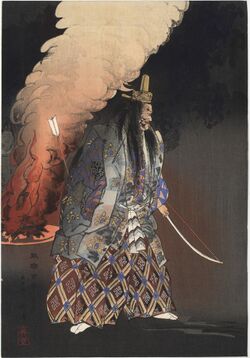Religion:Futodama
This article cites its sources but does not provide page references. (August 2021) (Learn how and when to remove this template message) |
| Futodama | |
|---|---|
 | |
| Personal information | |
| Parents | Takamimusubi |
| Children | Kamotaketsunumi no Mikoto |
Futodama (布刀玉命) is a god in Japanese mythology, claimed to be the ancestor of Imbe clan, whose characteristics are believed to reflect the functions of the clan as court ritualists.[1][2]
Name and etymology
The god is known as Ame-no-Futodama-no-Mikoto (天太玉命) or Futodama (布刀玉, 太玉) for short. His name is speculated to mean great gift or offering.[1][3][4]
Myths
After Susanoo accidentally killed one of Amaterasu's attendants in her weaving hall, she got upset and locked herself in Amano-Iwato causing the world to plunge into darkness, so Omoikane and other gods came up with a plan to get her out.[5]
Futodama and Amenokoyane were tasked with performing a divination.
After Amaterasu left the cave, Futodama used a shimenawa to prevent her from going back to the cave again. This story is said to be the mythical origin of shimenawa.[6]
In Kogo shūi, Futodama is placed as the leader of the preformed rituals.[2]
Family
| Takamimusubi | Amaterasu | ||||||||||||||||||
| Futodama | Takuhadachiji-hime | Oshihomimi | |||||||||||||||||
| Inbe clan | Ninigi-no-Mikoto | ||||||||||||||||||
In Kogo shūi Futodama is the child of Takuhatachijihime, and grandchild of Takamimusubi.[citation needed] But in many versions he is the son of Takamimusubi and the uncle to Ninigi.[7][2]
Worship
Futodama is believed to be enshrined at Awa shrine. Where there is a festival to the kami every year on August 10.[8] He is also enshrined at Amatsu Shrine alongside Ninigi and Ame-no-Koyane.[9] The Engi Shiki lists several shrines to Futodama in Izumi Province.[1]
Popular culture
In the Japanese role playing game Shin Megami Tensei IV Futotama is a level 42 demon. Futotama created other demons when fused, if he is fused with Virtue it creates Israfel. If Futotama is fused with Master Therion it creates Vivian.[10]
References
- ↑ 1.0 1.1 1.2 "Ameno Futodama • A History of Japan - 日本歴史" (in en-GB). https://historyofjapan.co.uk/wiki/ameno-futodama/.
- ↑ 2.0 2.1 2.2 "Encyclopedia of Shinto - Home : Kami in Classic Texts : Futodama". http://eos.kokugakuin.ac.jp/modules/xwords/entry.php?entryID=52.
- ↑ Aston, W. G. (2015-11-16) (in en). Shinto - The Ancient Religion of Japan. Read Books Ltd. ISBN 978-1-4733-7719-6. https://books.google.com/books?id=DNPOCgAAQBAJ&q=futodama+name&pg=PT135.
- ↑ Aston, William George (1905) (in en). Shinto, the Way of the Gods. Longmans, Green. ISBN 9780524006801. https://books.google.com/books?id=nyUNAAAAYAAJ&q=divination+futodama&pg=PA184.
- ↑ "Amaterasu" (in en). https://mythopedia.com/japanese-mythology/gods/amaterasu/.
- ↑ Bocking, Brian (2005-09-30) (in en). A Popular Dictionary of Shinto. Routledge. ISBN 978-1-135-79738-6. https://books.google.com/books?id=MWGQAgAAQBAJ&q=Shimenawa.
- ↑ Ponsonby-Fane, R. A. B. (2014-06-03) (in en). Studies In Shinto & Shrines. Routledge. ISBN 978-1-136-89294-3. https://books.google.com/books?id=BY23AwAAQBAJ&q=futotama+cousins&pg=PA11.
- ↑ Fr?d?ric, Louis; Louis-Frédéric (2002) (in en). Japan Encyclopedia. Harvard University Press. ISBN 978-0-674-01753-5. https://books.google.com/books?id=p2QnPijAEmEC&dq=Awa+shrine&pg=PA61.
- ↑ "Kotodamaya - Amatsu Jinja" (in ja). 21 January 2009. http://www.kotodamaya.com/amatsu-jinja/.
- ↑ Shin Megami Tensei IV - Strategy Guide. Gamer Guides. 7 November 2015. ISBN 9781631027192. https://books.google.com/books?id=BJHiCgAAQBAJ&q=Futotama.
 |


